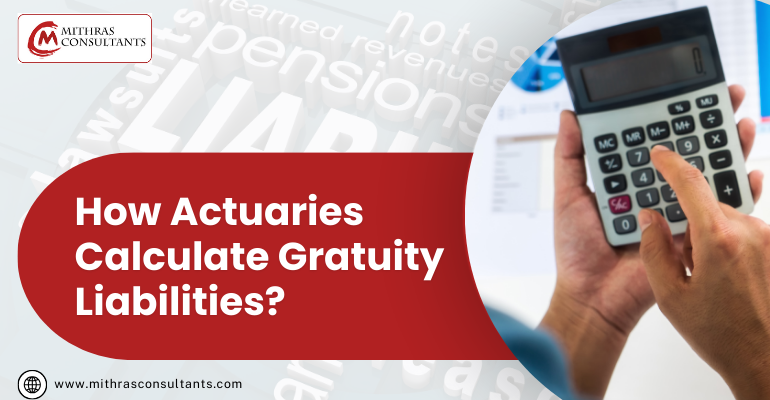How Actuaries Calculate Gratuity Liabilities?

Gratuity is an essential employee benefit that rewards long-term service. Companies must estimate their gratuity liabilities accurately to comply with financial and regulatory standards. Actuaries play an important role in determining these liabilities using mathematical models and financial assumptions. They assess factors such as employee tenure, salary trends, discount rates, and mortality rates. Their calculations ensure that businesses allocate sufficient funds to meet future gratuity payouts.
Understanding how actuaries calculate gratuity liabilities helps businesses stay compliant and financially prepared. Let us explain the process in detail, covering key methods and assumptions involved in actuarial valuation.
Understanding Gratuity and Its Importance
Gratuity is a statutory benefit paid to employees who complete at least five years of continuous service. It provides financial security to employees upon retirement, resignation, or termination. The Payment of Gratuity Act, 1972 governs gratuity payments in India. Companies must estimate gratuity liabilities to ensure they have adequate financial provisions for future payouts. This estimation prevents sudden financial burdens and ensures smooth business operations.
Key Factors Affecting Gratuity Calculations
Actuaries consider several factors while calculating gratuity liabilities. The key elements include:
- Employee tenure: Longer service leads to higher gratuity payouts.
- Salary growth rate: Future salary increments impact gratuity calculations.
- Discount rate: Determines the present value of future gratuity liabilities.
- Mortality rates: Estimates the probability of an employee’s continued service.
- Attrition rate: Accounts for employees who may leave before becoming eligible for gratuity.
These factors help actuaries make precise projections about future gratuity payments.
Methods Used in Actuarial Valuation
Actuaries use different valuation methods to estimate gratuity liabilities. The most common approaches include:
1. Projected Unit Credit (PUC) Method
The PUC method is widely used under AS 15, Ind AS 19, and IFRS standards. This approach values each year of employee service as a unit of benefit. The method calculates the present value of future gratuity benefits based on the employee’s projected salary at the time of retirement. This ensures a realistic estimate of the company’s financial obligations.
2. Entry Age Normal (EAN) Method
The EAN method spreads the cost of future gratuity benefits evenly over the employee’s service period. This method calculates a level annual contribution needed to fund gratuity payouts. Companies use this approach to maintain a steady financial provision for gratuity obligations.
3. Accumulated Benefit Obligation (ABO) Method
The ABO method calculates gratuity liabilities based on the employee’s current salary and service years. It does not factor in future salary increments, making it a conservative approach. This method is useful for companies that prefer a lower liability estimation.
Key Assumptions in Gratuity Calculations
Actuarial calculations rely on several assumptions to estimate gratuity liabilities accurately. These assumptions include:
1. Discount Rate
Actuaries use government bond yields to determine the discount rate. A higher discount rate reduces the present value of liabilities, while a lower rate increases it.
2. Salary Escalation Rate
Future salary increments impact gratuity payouts. Actuaries analyze industry trends, inflation, and company policies to estimate this rate.
3. Employee Attrition Rate
Attrition rates affect the number of employees eligible for gratuity payouts. Companies with high attrition rates may have lower long-term gratuity liabilities.
4. Mortality Rate
Actuaries use mortality tables, such as the Indian Assured Lives Mortality Table (IALM), to predict employee life expectancy and service duration.
Steps in Actuarial Gratuity Calculation
Actuaries follow a structured process to estimate gratuity liabilities:
- Data Collection:
- Gather employee details such as age, tenure, and salary.
- Identify company-specific gratuity policies and financial provisions.
- Assumption Selection:
- Determine discount rates, salary escalation rates, attrition rates, and mortality assumptions.
- Application of Valuation Method:
- Use the PUC, EAN, or ABO method to calculate gratuity liabilities.
- Present Value Calculation:
- Apply the selected discount rate to estimate the present value of future gratuity payouts.
- Reporting and Compliance:
- Provide actuarial reports as per AS 15, Ind AS 19, and IFRS guidelines.
- Ensure financial statements reflect the company’s gratuity liabilities accurately.
Importance of Actuarial Gratuity Valuation
Accurate gratuity valuation is crucial for financial stability and regulatory compliance. The key benefits include:
- Ensures financial preparedness: Companies can allocate sufficient funds for future gratuity payouts.
- Complies with accounting standards: Helps meet legal and financial disclosure requirements.
- Prevents sudden financial strain: Businesses can plan their cash flow efficiently.
- Aids decision-making: Management can make informed financial and HR-related decisions.
Conclusion
Actuaries play a vital role in calculating gratuity liabilities using structured mathematical models and financial assumptions. They consider employee tenure, salary growth, attrition rates, mortality rates, and discount rates to estimate future obligations.
Mithras Consultants is an independent actuarial and insurance consultancy firm providing qualitative financial and insurance solutions to its clients. Our goal is to provide business solutions customized to clients’ needs to help them make the best possible decisions on their financial, insurance, and risk management programs.

 Call Us
Call Us Whatsapp Us
Whatsapp Us